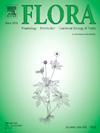墨西哥中部三种豆科豆属植物的解剖叶多样性及其分类意义
IF 1.8
4区 生物学
Q3 ECOLOGY
引用次数: 0
摘要
Lupinus L.在美洲大陆约有280种,具有很高的多样性。关于这方面的知识和分类界定仍然很少,而且不一致。解剖特征为若干植物类群的分类分辨率提供了信息,然而,对狼属植物的分类分辨率却很少。本研究的目的是对形态上分离较好的三种Lupinus进行比较解剖分析,研究其叶片结构,评价其性状的分类学意义,以确认其现有分类,揭示该类群尚未报道的解剖学特征。本研究利用了三种不同部位的小叶和叶柄。, L. hintonii C.P. Smith和L. mexicanus Cerv。交货延迟。收集,在野外固定,并使用常规组织学技术进行处理,以包含在近质体和永久制备的横截面中,并进行表皮表征。检验了32个定性性状和25个定量性状。后者是基于统计分析。描述了小叶和叶柄的组织学结构。统计分析表明,近轴气孔的丰度、位置和长度、背斜壁的厚度、近轴表皮细胞的高度、毛状体的类型和密度、近轴乳突的高度、叶肉的类型、中脉的大小、小叶中部导管的直径等特征是分种的依据。表皮细胞的轮廓和高度、厚壁层的类型和数量、维管束的排列和数量以及叶柄中空隙的位置。定性和定量性状的结合表明,种内,特别是种群间具有高度的相似性。11个性状将L. mexicanus种群Lm3与其他两个种群区分开来,表明它是一个独特的物种。本文章由计算机程序翻译,如有差异,请以英文原文为准。
Anatomical-foliar diversity in three species of Lupinus L. (Fabaceae) from central Mexico and its taxonomic implications
Lupinus L. comprises approximately 280 species with high diversity in the American continent. The knowledge and taxonomic delimitation of this is still scarce and inconsistent. Anatomical characters provide information for the taxonomic resolution of several plant groups, nevertheless, that is scarce for Lupinus. The objective of this study is to conduct a comparative anatomical analysis of three species of Lupinus which are morphologically well separated, investigate the structure of their leaves to evaluate the taxonomic significance of their characters for confirm their existing classifications and reveal anatomical characteristics that have not yet been reported for the group. The study utilizes leaflets and petioles from three distinct localities of L. bilineatus Benth., L. hintonii C.P. Smith and L. mexicanus Cerv. ex Lag. were collected, fixed in the field, and processed using conventional histological techniques for inclusion in paraplast and permanent preparations of cross sections and for epidermis characterization. Thirty-two qualitative and twenty-five quantitative characters were examined. The latter were based on statistical analyses. The histological structure of the leaflet and petiole are described. The statistical analysis showed that some characters distinguish the species, as the abundance, location, and length of adaxial stomata, the thickness of the anticlinal wall, the height of adaxial epidermal cells, the type and density of trichomes, the height of adaxial papillae, the type of mesophyll, the magnitude of the midrib, diameter of vessels in middle in the leaflet. The outline and height of epidermal cells, type and number of collenchyma strata, arrangement and number of vascular bundles and location of air spaces in the petiole. The combination of qualitative and quantitative traits indicates a high degree of similarity within the species, particularly between the populations of L. hintonii. Eleven characters differentiates the L. mexicanus population Lm3 from the other two, suggesting that it is a distinct species.
求助全文
通过发布文献求助,成功后即可免费获取论文全文。
去求助
来源期刊

Flora
生物-植物科学
CiteScore
3.30
自引率
10.50%
发文量
130
审稿时长
54 days
期刊介绍:
FLORA publishes original contributions and review articles on plant structure (morphology and anatomy), plant distribution (incl. phylogeography) and plant functional ecology (ecophysiology, population ecology and population genetics, organismic interactions, community ecology, ecosystem ecology). Manuscripts (both original and review articles) on a single topic can be compiled in Special Issues, for which suggestions are welcome.
FLORA, the scientific botanical journal with the longest uninterrupted publication sequence (since 1818), considers manuscripts in the above areas which appeal a broad scientific and international readership. Manuscripts focused on floristics and vegetation science will only be considered if they exceed the pure descriptive approach and have relevance for interpreting plant morphology, distribution or ecology. Manuscripts whose content is restricted to purely systematic and nomenclature matters, to geobotanical aspects of only local interest, to pure applications in agri-, horti- or silviculture and pharmacology, and experimental studies dealing exclusively with investigations at the cellular and subcellular level will not be accepted. Manuscripts dealing with comparative and evolutionary aspects of morphology, anatomy and development are welcome.
 求助内容:
求助内容: 应助结果提醒方式:
应助结果提醒方式:


